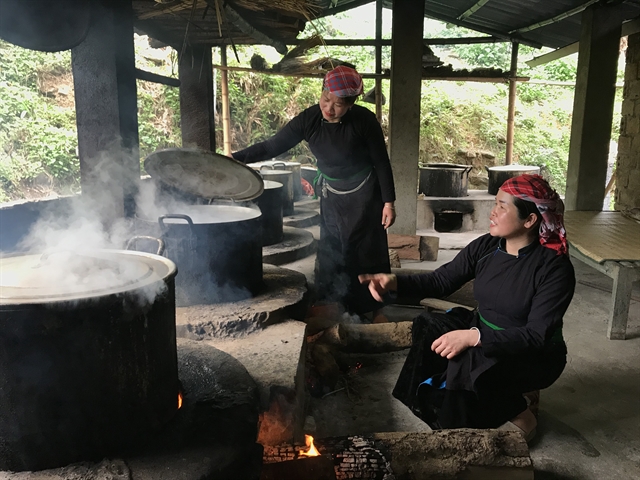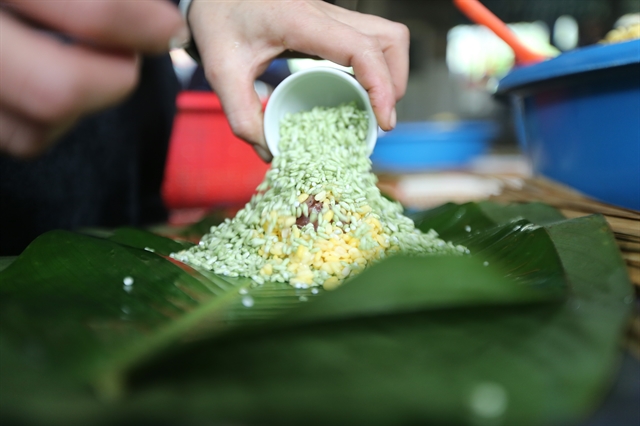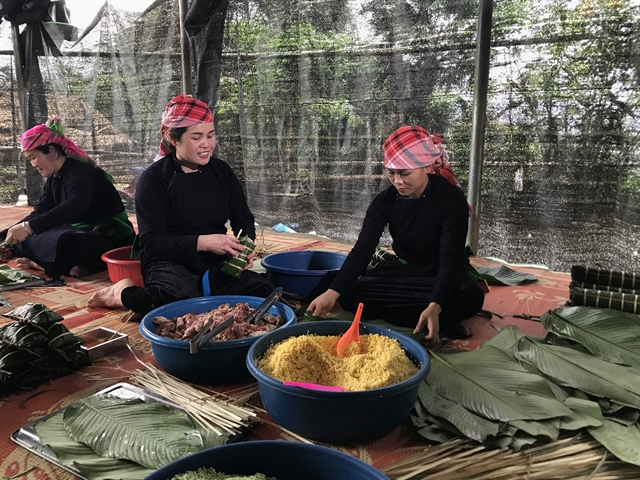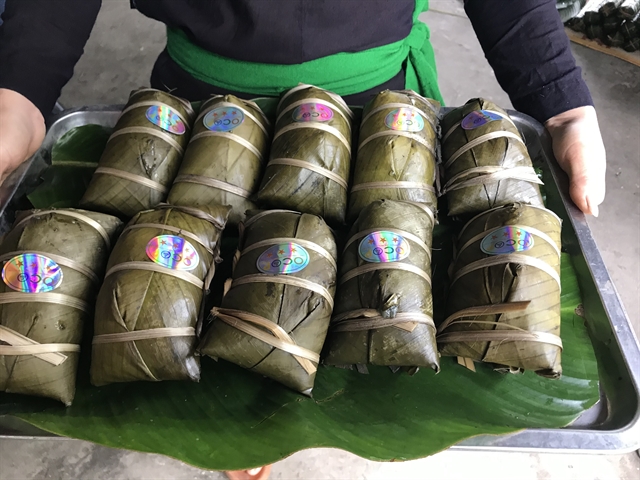 Life & Style
Life & Style

The Tày ethnic group in Văn Bàn District, in the northern province of Lào Cai, are renowned for their black sticky cake – a popular dish and an indispensable custom for festive events.
Lê Hương
The Tày ethnic group in Văn Bàn District, in the northern province of Lào Cai, are renowned for their black sticky cake – a popular dish and an indispensable custom for festive events.
As well as being a delicious dish, the black sticky rice cake is a cultural symbol of the locality.
Among the most prestigious traditional cake making workshops, the one owned by Hoàng Thị Huế in Khánh Yên Town provides the tastiest cakes to not only locals but also neighbouring provinces and cities.

|
| Hoàng Thị Huế boils sticky rice cake at her home, also her workshop. VNS Photo Lê Hương |
Her product has been granted a provincial-level three-star OCOP (One Commune One Product) certificate for good quality and clear origin.
“Currently, there are diverse kinds of sticky rice cake products in Lào Cai Province,” Huế said proudly. “Yet cakes made in Văn Bàn still have more significant colour and distinguished taste than those made in other localities.”
Huế said her careful selection of ingredients and secret tips handed down through generations have resulted in success.

|
| The form of black sticky rice cake bears the philosophy of yin and yang. VNS Photo Nguyễn Nam |
The black cakes are made of local Cẩm Dương sticky rice, green bean, fresh pork, dong leaves, spices and powder from the burnt flour of núc nác (Indian trumpet flower), which bring the black colour for the cake.
Locals gather núc nác plant, dry it, burn it and pound it to get a black powder. The powder is then mixed with the sticky rice, which is then used to make the cake. Tày people wrap the inside of the cake on dong leaves in a square, round, or cylinder form. The cake is boiled for between 10 to 12 hours. When the cakes are cooked, the sticky rice smells good with the yellow-green beans inside, fatty pork, pepper and the smell of dong leave and the fragrance of núc nác plant.
Huế said the núc nác powder helps the black sticky cakes stay fresh for 7-10 days at room temperature in winter and 3-5 days in summer.
The núc nác powder has anti-biotic and anti-inflammation features among other good usages that make it a popular herbal medicine, she said.

|
| The ingredients are chosen carefully. VNS Photo Nguyễn Nam |
Profound meaning
According to folk culture researcher Hà Lâm Kỳ, in the past, there was a salt scarcity in the northwestern region.
The ancestors of today’s Tày ethnic group went to the forest and chopped down a kind of tree called the 'salt tree' to bring home. They took the bark of the tree, dried it and burnt it to coal. They used that kind of coal in cooking instead of sea salt. The black colour in sticky rice was created by the coal powder from that tree.
When it is cooked, the cake has a salty flavour and a little smell of wild plants. Besides the salt tree, Tày people also use cây gùn (a local wild plant) or cỏ chanh (grass with the smell of lime) and burn them to make coal powder for making the cake.

|
| Cut cake. Photo daidoanket.vn |
“This was an innovation by the Tày people when they had to overcome difficulties in life and live with nature,” Kỳ said.
Kỳ added that the way to wrap the black cake features a yin-yang balance.
Tày people think heaven is round while the earth is square, which is expressed in the form of the cake: a round body and both ends in square form.
Yin-yang features are also found in the way they use the dong leaves, with two placed at two different sides and ends facing each other. The number of bamboo strings used to tie the cake is an odd number, either five or nine.
“The figures follow circulation: birth – old age – weakness – death – birth again,” Kỳ said. “It always contains liveliness and development.”
When giving one another the cakes as a gift, they always give them in a pair to create a harmony of yin and yang.
When they tie up the bamboo string, Tày people tie it in a spiral. One bamboo string is tied above another one, which holds the cake firmly inside the leaves while the sticky rice swells inside in the heat.

|
| Huế's workshop offers a stable income to many local women. VNS Photo Lê Hương |
Kỳ said the way of tying bamboo strings means the next generation obeys those that came before them.
When the cake is well cooked, locals use bamboo to cut the cake into many small pieces.
Besides boiled black cake, people may also bake cakes by putting them on coal till the insides smell good. VNS

|
| Sticky rice produced at Huế's workshop has an OCOP stamp to ensure the origin and quality of the product. VNS Photo Lê Hương |




